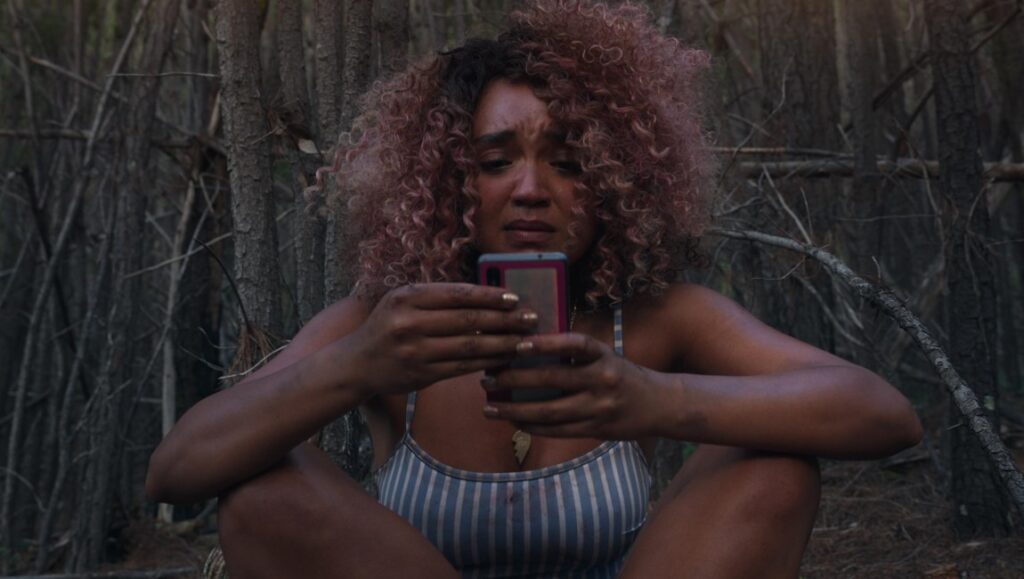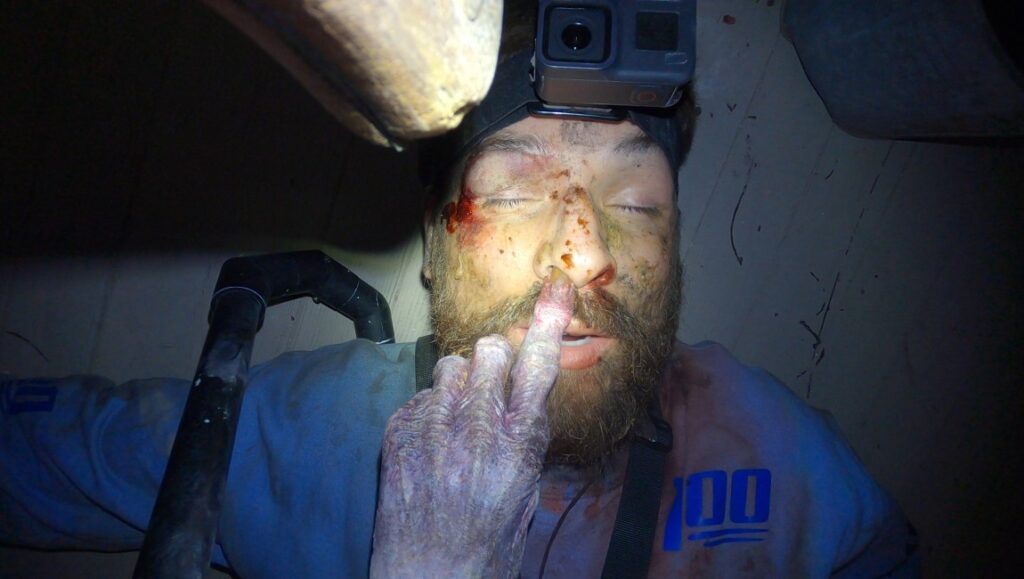Spin Me Round
Jeff Baena’s Spin Me Round, co-written with its star Alison Brie, sets out as a comedic take on the very Hollywood idea of an American girl finding love abroad. Brie plays Amber, a manager of the movie’s Olive Garden stand-in, Tuscan Grove, who wins a manager’s retreat to Italy. For a while, the film proceeds as a feather-light comedy, playing the reality of staying in a bum hotel and attending boring courses against the expectations of life in a villa, until she meets Tuscan Grove CEO Nick (Alessandro Nivola) and begins what seems like the European romance of her dreams. For a bit, the film falls into a holding pattern between the increasingly strange and alarming relationship between the pair and the mostly annoying comedy taking place back at the retreat, which finds gifted comedic actors like Tim Heidecker and Zach Woods mostly sleepwalking. It alternates between mysterious and grating at the drop of a hat, almost always feeling like two halves of different movies, both mediocre.
Eventually, Nick and Amber’s clandestine relationship and its fallout take center stage as Amber and fellow retreater Dana (Zach Woods) dig into a possible conspiracy at the root of the Trojan Grove managers retreat, one that further points to relevant, post-#MeToo social concerns that the film repeatedly toys with. But it pulls back, flinches at the thought of exploring anything potentially thorny in favor of its preferred cheap comedy. A series of rug pulls in the finale do less to make our protagonists out to be paranoid and more to turn the whole film into a joke, one at the expense of anyone watching it, walking up to a queasy line before backing away again and again. In the end, Spin Me Round offers little more than a light subversion of European vacay romcoms, despite its empty gestures toward more intriguing, spikier ideas.
Aubrey Plaza is the easy bright spot of Spin Me Round, as the actress continues to prove her versatility and magnetism even in roles, like this one, that feel like a limiting step backwards for her, particularly compared to something like her riveting dramatic turn in Black Bear. As Nick’s assistant Cate, Plaza plays a variation on her old disaffected cool girl standby, but this time afflicted with a little more sexual energy. After carting Amber to and from several rendezvous with her boss, Cate and Amber take off on their own for the night, and the film briefly and electrically hints at possibilities between the pair. But like every other tantalizing thread Baena and Brie dangle in their script, it’s dropped in favor of a dumb, less engaging mystery. Throughout Plaza is the most engaging screen presence — admittedly not hard to accomplish here — and every scene without her begs for her spark. And so the choice to have her disappear from the movie midway through is but the worst in a sea of bad ones, a blunder that effectively eliminates our distraction from the sinking ship.
Writer: Chris Mello

Sissy
Viewers of a certain age might remember the SNL character Stuart Smalley and his frequently spouted catch phrase, “I’m good enough, I’m smart enough, and doggone it, people like me.” Filmmakers Hannah Barlow and Kane Senes presumably do, putting an almost verbatim mantra in the mouth of Cecilia (Aisha Dee), a 20-something social media influencer and the protagonist of their new dark comedy slash psychological thriller cum horror film Sissy. Cecilia is introduced recording a video for her 200,000+ followers that finds her meditating and illustrating how to make one’s very own safe space with a rope, before pausing to hawk some facial cleanse products. After she wraps up, the camera proceeds to follow her around her filthy, cluttered apartment. The point is clear: Cecilia isn’t as centered and put together as she pretends to be. Instead, she lounges on her couch watching bad reality TV, glued to her phone as the likes and comments come pouring in. She’s addicted to her own feed, desperate for the validation she receives with each new post. Is she a huckster, a fraud, a charlatan? For her part, Dee is a remarkably charming performer, investing Cecilia with a very real humanity that butts up against the social media satire on display. Regardless, the filmmakers keep Cecilia’s true nature vague, to increasingly diminishing returns.
Sissy’s plot kicks in when Cecilia runs into an old friend, Hannah (played by co-writer/director Barlow) at a grocery store. The two were inseparable as adolescents (back when Cecilia still went by her nickname, Sissy), until something caused a schism between them. Now, a decade later, Hannah is eager to reconnect, immediately inviting Cecilia first to a karaoke party and then to her bachelorette weekend getaway. Cecilia is reluctant, but decides to go; also attending is Hannah’s fiancé, Fran (Lucy Barrett), and a few hip, fashion-obsessed friends. Unfortunately, this weekend getaway is being hosted by Alex (Emily De Margheriti), Cecilia’s childhood bully and the cause of the rift between Cecilia and Hannah. Barlow & Senes parcel out this background information in brief, oblique flashbacks that gradually expand as the narrative progresses. Much like Cecilia’s true character, our understanding of these scenes fluctuates as the audience receives more and more information, reconfiguring sympathies and throwing into question who, exactly, was the instigator.
It’s hard to pinpoint exactly what doesn’t work about Sissy, as the dark, cringey humor eventually gives way to a full-blown slasher film. Cecilia becomes increasingly uncomfortable around her host, as Alex makes it clear that Cecilia isn’t really welcome here. The filmmakers underline the gap between the parties by grouping Hannah and the others together into shots while keeping Cecilia separated by edits or by the architecture of the frame. But is Alex really a bully, or does she have a good reason to distrust Cecilia? It would be a disservice to unsuspecting audiences to give too much away here; suffice to say that emotions flare and the party goers begin meeting unnatural ends, leading to some stunningly violent set pieces. But it’s a hollow kind of violence, good for a few shocked guffaws but lacking any real teeth. Ultimately, it’s the absence of any consistent point of view that seems to doom the film. Barlow and Senes appear prepared, eager even, to take the piss out of contemporary Internet culture, gently mocking “safe spaces” and “trigger warnings.” But they also want us to sympathize with Cecilia; she is, after all, very clearly the victim of bullying, and the film carefully delineates how crass her peers are. The fact that Aisha Dees is Black adds a racial dimension to the violence that the filmmakers don’t seem interested in exploring, ditto the fact that the other main characters are a pair of soon-to-be-married lesbians, an Asian woman, and a disabled gay man. The film is chock full of contemporary cultural signifiers and Internet buzzwords that all add up to very little. In fact, if one were to take any of the film’s musings on mental health seriously in any way, it’s borderline offensive. None of this might matter if the sharp turn to horror brought genuine scares along with it, but despite the ample viscera on display, there’s no real tension or suspense there, either. Sissy wants to have its cake and eat it too, vacillating wildly between a good-faith exploration of childhood trauma, psychological realism, and a schlocky gore-fest with exploding heads and mangled limbs. All the ingredients are there, but they don’t add up to anything delicious.
Writer: Daniel Gorman
Slash/Back
Nyla Innuksuk’s Slash/Back opens to the singular vocal stylings of Inuk throat singer Tanya Tagaq. Listeners familiar with the performer will understand the chugging, off-kilter energy such an association brings to bear, one suggestive of a primal, terrestrial character, and one the subsequent film aspires to and sometimes embodies but can’t always quite muster. The narrative sketch is a familiar one: alien invasion visits itself upon a small community, ragtag teens lead a grassroots resistance. Take that premise to its logical, low-budget limits, and set that story in the tiny Baffin Island hamlet of Pangnirtung, Nunavut, and you’re pretty close to the core of Innuksuk’s feature directorial debut.
The specific players here are de facto leader Maika (Tasiana Shirley), her best friend Jesse (Alexis Wolfe), hyperactive yarn-spinner Uki (Nalajoss Ellsworth), and reserved, phone-obsessed Leena (Chelsea Prusky). As the film opens, the bored foursome head out onto “the land” for a lazy afternoon, borrowing Maika’s dad’s boat and rifle. Good thing too, as Maika’s younger sister (who has followed them) is suddenly attacked by a strangely behaving polar bear, which Maika shoots. Uki, a committed fabulist, at first suspects mythic origins, which the others quickly dismiss, but after she later heads back out to further inspect, she is likewise attacked, changing her theory — correctly — to an alien invasion. The others are again reluctant to believe Uki’s outlandish claims, until a pair of local police officers are overtaken by said extraterrestrials, crashing a group hang with their newly writhing, withered bodies.
It’s here that Slash/Back is at its best. The FX work is a mix of practical and computer-generated effects, but it’s the former that lends the film a squirmy and appealingly nostalgic quality. There’s a jarring moment of calibration upon our first encounter with the polar bear, his charging gait too gangled, the motion all wrong, establishing a creepy vibe without yet tethering the moment to any discernible explanation. It’s a singular enough image to hold onto until the body-snatched officers arrive, the tentacled aliens wearing their distended, sagging bodies like dad’s old suit — the effect suggests what that scene from Harry Potter and the Deathly Hallows: Part 1 where a snake wears an old woman’s body should have looked like. But rather than any monolithic contemporary franchises, Slack/Back shares far more DNA with low-budget ‘80s sci-fi and body horror flicks, a texture that pairs nicely with the vein of earnestness that runs through the film, a quality which could have been cloying were it not for the film’s small-scale, homegrown feel. Few films in the increasingly regurgitative and soul-dead movie industry feel like true labors of love anymore, but on that front, Slash/Back is unimpeachable, its joy as palpable as its gooey effects.
But for all that, there’s simply too much filler; Slash/Back barely clocks 80 minutes, but spends too much of it accelerating through various interpersonal conflicts — boy problems, some public bullying, etc. — and empty commentaries that are suggested but never explored: class disparity, alcoholism, and technology addiction are all introduced and then immediately dropped. Which is certainly for the best in terms of keeping the attention on the film’s gnarly aesthetic, but the introduction of such elements does cast a light on how threadbare even the most playful parts here are. Even the film’s visual design, FX work notwithstanding, feels lacking: a culminating scene, two bodies silhouetted against an orchid- and navy-colored twilight sky, waves lightly breaking behind a cruising motorboat, suggests the potentially beautiful compositions the gorgeous locale might have afforded but which never materialize. Still, it’s nice to see an indigenous production that doesn’t feel compelled to explicitly foreground issues of indigeneity — a welcome byproduct of growing representation, specifically in Canadian cinema — and if the film’s notable slightness means its doesn’t register as a considerably substantial success, it’s still a diverting, charming girl power romp and pleasant digestif to the smorgasbord of bloated blockbuster IP that saturates our screens.
Writer: Luke Gorham

Deadstream
Joseph and Vanessa Winter’s Deadstream gets off to a rough start, playing like an introduction to one of the world’s most annoying YouTube streamers in Shawn Ruddy (Joseph Winters). Ruddy is back to streaming after a particularly insensitive stunt left his channel demonetized and caused all of his sponsors to pull out, the kind of controversy that guys like the Paul brothers and Pewdiepie continually bounce back from. But with new sponsors at his side, he’s now promising The Wrath of Shawn’s most cinematic and possibly most dangerous stunt yet: one night in the most haunted house he can find, all livestreamed of course. This setup immediately calls to mind the similar premise of Jung Bum-shik’s terrifying Gonjiam: Haunted Asylum, only with a single irritating man in place of a whole cast of characters. By the time Shawn is in the house, Deadstream seems doomed to fail, a manic, unfunny satire of an easy, if deserving, target. And while spending time with this character never gets easier per se, the Winters’ film actually starts surprising soon after the promised ghosts show up.
As it turns out, Deadstream has less in common with Gonjiam than with The Evil Dead, sharing with Raimi’s film a creature and gore design ethos, along with a specifically pitched comedic tone — a ghoul smashing Shawn’s head into the ground while shouting “smash that like button” shouldn’t work, but full-throated, creative commitment to the bit sells it. When the film is in full swing, it’s a tour through very effective jump scares, gross-out effects work and spooky atmosphere. If Shawn never becomes less irritating, Deadstream at least gets funnier as it gets scarier, either through the population of Shawn’s chatroom and his deranged commitment to engaging with the comments no matter what’s happening or through the ghosts’ commitment to psychic damage in the way of barbed, specific insults (something again borrowed from The Evil Dead). The film never approaches a particularly deep, engaging satire of the live-streaming model, but it’s at least an accurate piss-taking, using loud-mouth, well-informed demons to skewer YouTuber apology videos. More than existing only on the level of surface scares and humor, the Winters borrow from Raimi a commitment to exciting filmmaking. Shawn promises his viewers the “most cinematic experience in live streaming,” which plays out through him attaching cameras to everything and letting his stream bounce between them. If he puts together a makeshift spear, he’ll attach a camera to it, all the better if something takes the weapon from him. Hell, even the monsters chasing Shawn might have a camera attached at an opportune moment. For Shawn, it’s all part and parcel of a commitment to making an interesting stream even in extreme danger. For the Winters, it’s a smart, playful way to ensure their found footage movie is stylistically a cut well above the standard.
Writer: Chris Mello
The Cellar
Brendan Muldowney’s The Cellar has all the hallmarks of your run-of-the-mill, austere haunted house movie. It features a family with some light problems for a haunting to exacerbate, very creepy stairs to a dark, creepier basement, more overlong and perfectly still shots of ominous doorways than you can count and, worst of all, a misguided commitment to restraint to the point that barely anything happens. But this isn’t a film where portraits fly off walls and ghosts jump out of dark corners, and is instead one with a few light, uneventful scares, like a repeated shot of an abacus slowly moving on its own. Were these scenes sustained, they might still have proven dread-inducing, but spaced out as they are, they only feel like deadening beats on the way to an admittedly more exciting finale.
Keira Woods’ (Elisha Cuthbert) family has moved into a big home they bought for dirt cheap at an auction, further driving a wedge between herself and her anarcho-curious teenage daughter, Ellie (Abby Fitz). Keira works in marketing, projecting images of teenage girls to the public that Ellie thinks are completely false, nevermind that her mother has no time to get to know her as she’s always working. The rift between them is literalized when Ellie disappears in the house’s cellar while on the phone with her mother. For the rest of the film, Keira investigates her daughter’s disappearance and uncovers the truth about her new home. And therein lies the problem: for much of The Cellar, Muldowney is more concerned with explaining why the house is haunted than with actually making the haunting exciting on its own. Outside of the disconnect between Keira and her daughter, he’s plainly uninterested in metaphor too, so the deep dive into “why” is nothing but gibberish to explain the film’s barebones internal logic. What could have been tossed off in an expository scene or two instead becomes a slog of a midsection involving everything from Jewish mysticism and alchemy to quantum physics and advanced mathematics.
All this nonsense is mere setup for the film’s last act, which places the rest of Keira’s family in imminent danger and delivers on showing the evil presence in the cellar at work. It’s patently rote horror movie stuff, but it’s also certainly more effectively frightening than the rest of the film. But when so much has been spent trying to differentiate its horrors in excruciating detail, the final act falling back on largely basic scares is still a disappointment. If The Cellar were less wrapped up in unintelligible minutiae, its bleak ending might have been an impressive swing. But as is, it instead makes the film feel like time wasted, a dull march to an inevitable conclusion.
Writer: Chris Mello

TikTok, Boom
Documenting the most downloaded phone app of all time is a daunting task. Director Shalini Kantayya is aware of such a prospect; right at the beginning of her documentary TikTok, Boom., we hear that “it’s a cybersecurity story, it’s an algorithm story, it’s a bias story, it’s a geopolitical story.” One of the first images we see is of popular influencer Charli D’Amelio dancing with a darker skin complexion, edited as if to hint at how her meteoric rise is due to dances made by Black choreographers. Such provocation ends up being mere suggestion, though, as this notion isn’t elaborated upon at length. This, then, is the problem of Kantayya’s documentary: There are far too many ideas tackled, and all have been written about countless times — including by one of the film’s talking heads, culture writer Taylor Lorenz — and so watching this feels like speed-reading any dozen articles about the app from the past few years.
It’s also hard to determine who this film is for, exactly. Many viewers who are interested in watching are likely familiar with TikTok already, but many of the points expressed have gone viral across social media, including on the app itself. Those completely unaware of its many facets and narratives, however, would be better off finding alternative info-dump prospects as the doc is too scattershot to be much compelling. It’s also far less thrilling than using the app itself, making zero attempts to mirror its addictive endless stream of content, the importance of its popularity to the wide acceptance of vertical videos, or mirroring the surreal experience of finding one’s For You Page tweaked in real time.
One of Kantayya’s clear strategies with TikTok, Boom. is to focus on content creators. We learn about Feroza Aziz, Deja Foxx, and Spencer X. The former two have humanitarian interests, while the latter is a beatboxer whose success has led to a collaboration with Jason Derulo. Stories of acceptance, community, and the terror of always being perceived — especially when young — are familiar to the point of banality in 2022, but more than just being commonplace, their respective lives are uninteresting here because Kantayya rarely allows their stories to breathe, to depict them beyond straightforward interviews and previously made TikTok videos. When we hear about Deja Foxx’s anxiety or how Trump’s proposed banning of TikTok would leave Spencer X without a career, such tragedies are treated with the same blandness as overarching points regarding China’s increasing tech dominance in America, predatory users, and childhood fame.
What results is a film that’s consistently shallow. There are even points where the film leans toward Sinophobia, doing little to question the supposed “horrors” of Americans needing to adjust to Chinese cultural customs. While censorship is touched upon, everything present is handled with little nuance, and the film’s inability to tackle such complex topics is obvious when we see Deja Foxx’s work on Kamala Harris’s TikToks — there’s a noticeable myopia here. At one point, when we hear that recommendation systems, something inherent to TikTok’s algorithmic foundation, are making decisions for generations of people, such consternation is met with a shot of teenagers in a living room, staring at their phones — safe to say, it’s not the most harrowing stuff.
The film’s final passages sum up its inarticulate, inelegant nature. The emotional climax arrives with moody synths as Spencer X starts to cry and confesses, “Being a beatboxer, it was so hard for me to be accepted.” Such a statement feels inert after the more distressing realities of the other influencers, but even worse is that it feels like Kantayya is willing as many emotional beats as possible. After this, and learning of Spencer X’s success, we learn of the LOG OFF movement, which is at direct odds with the fact that TikTok led to these influencers’ success in the first place — the struggle between churning out content and enjoying one’s career is touched upon earlier, but has by this point disappeared. “TikTok won,” is the anticlimactic revelation at the end of TikTok, Boom. This was, of course, obvious since the beginning of the film, and points to how much of Kantayya’s documentary is dead on arrival.
Writer: Joshua Minsoo Kim


Comments are closed.